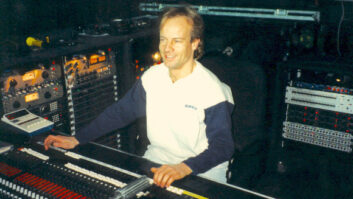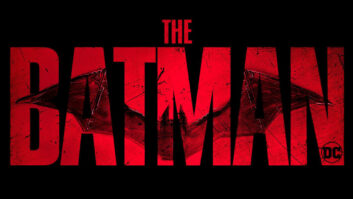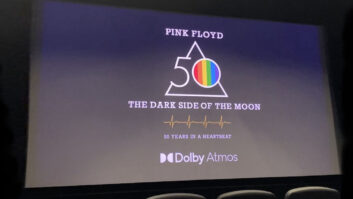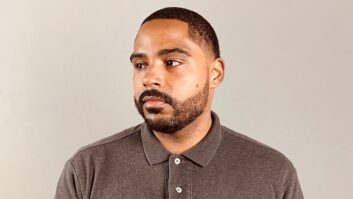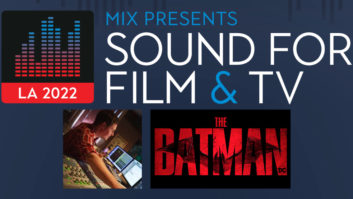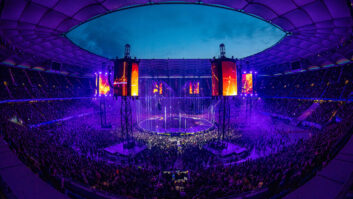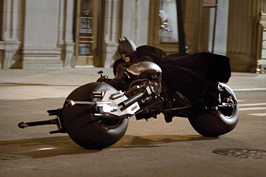
This may be the Summer of the Hero, from Iron Man to Indy to The Incredible Hulk, yet it’s hard to shake the impression that something very strange is going on in Christopher Nolan’s The Dark Knight, the follow-up to Batman Begins.
Photo: Stephen Vaughan/Warner Bros. Pictures. TM and ©DC Comics.
“Chris has continued the development of the characters from Batman Begins, and introduced a maniacal force of nature — The Joker — who’s like a hurricane that blows through the whole movie and seems basically unstoppable,” says sound designer and supervising sound editor Richard King during a break from working on the final with re-recording mixers Lora Hirschberg and Gary Rizzo at Warner Bros.’ Neve DFC-equipped Stage 9.
King is a veteran sound supervisor who won an Oscar for the 2003 Master and Commander, was nominated for War of the Worlds in 2005, and has worked on such diverse recent films as Lemony Snicket’s A Series of Unfortunate Events, The Prestige and The Assassination of Jesse James by the Coward Robert Ford.
“Every film presents unique challenges,” he comments, “and every filmmaker’s vision is different, so I can’t say there’s anything I’ve done before that really prepared me for The Dark Knight. It’s been a long process. I came on about a year ago and did a month of sound design work without seeing any picture, just based on the script and what I imagined things would look like. This was as they were beginning the shoot in England and the picture editor, Lee Smith, asked me for a library of sounds to cut with. Then in October/November, we prepared and mixed the IMAX trailer, or prologue, which was released in December. Several scenes in the film were shot with IMAX cameras, and there will be a simultaneous IMAX release for which we’ll do a special mix.”
King says there’s little in the way of sonic continuity between this film and the 2005 Batman Begins (which he did not work on) other than the sound of Batman’s voice, “which mostly differs from Bruce Wayne’s voice in [Batman actor] Christian Bale’s performance, plus a little console EQ. Chris also wanted some similarity in the sound of the Batmobile, although we weren’t required to slavishly replicate it. For this we used huge gas engines from both high-speed race boats and cars, big electric turbines, and the occasional processed animal roar or scream for emphasis.
“Batman’s other ride is the Batpod — a large, very impressive-looking motorcycle,” King continues enthusiastically. What was the approach? “Chris liked the concept of the Shepard Tone, which, simply put, is a continually ascending tone: If you imagine a musical scale and you overlap it with the same material pitched to a different octave, you can crossfade from one to the other, creating the illusion of continually ascending (or descending) pitch. We used this concept with the Batpod, so it sounds like it’s always accelerating. The Shepard Tone works best with fairly pure sounds, so that led us to electric motors, which also matched the sleek look of the Batpod. We recorded a lot of big electric motors and a couple of electric race cars — like the Tesla and a Wrightspeed X1 prototype,” even putting them on a dynamometer, which allowed King to record extreme acceleration and engine torque in a very controlled fashion without the car actually moving.
As has been the case on many films King has worked on, he was aided and abetted by top Hollywood sound recordists John Fasal and Eric Potter (profiled in the July 2005 issue of Mix), who brought their arsenal of Sound Devices 744 recorders to that and other tasks, such as recording a variety of weapons and various vehicles for the film.
“Then we experimented with tires,” King continues. “The Batpod has huge, wide tires, and we knew that would be an important component, so we spent a lot of time recording different kinds of tires, like off-road tires on trucks, knobby tires on all-terrain vehicles — just experimenting, trying to find a good tire sound. One day, I was running on my treadmill and I dragged my running shoe over the back of the tread as it was moving, and thought, ‘That’s a cool sound!’ So I recorded it on my little Sony PCM D-1 and that’s been integrated with the other tires into the Batpod tire sound. It’s been an evolution, which still continues!”
Though obviously there are a number of fantasy elements like that in the film, King says that Nolan’s overall approach is “to go for a very gritty, real-world feeling. There are some truly spectacular action scenes. But these big set pieces don’t rely solely upon visual effects; they’re mostly composed of practical shots. And that helps establish the reality of what you’re seeing, and in a sense grounds the movie. People are so accustomed to seeing fantastic CGI images that when they see a fantastic image that they can tell was actually shot with a camera, I think it makes even more of an impression. We’ve tried to keep the track gritty and real, and then when Batman appears on the scene and does his thing, we ratchet up the coolness factor and make everything sound bigger and more awesome. The contrast between gritty and naturalistic and epic and hyper-real makes for an interesting track.” This same philosophy extends to the production sound, recorded by Ed Novick. “There are very few ADR lines in the film,” King says. “Chris loves the sound of the production, and Gary Rizzo did a wonderful job of weaving it together.”
When King and I spoke in mid-May, he and the mixers were working on a climactic chase scene involving the Batmobile and several other vehicles, and he seemed particularly excited, because, “Chris decided to play the scene with sound effects and no music for the most part, which is rare for a scene like this, so it’s been a great opportunity for Lora, Gary and me to look at the sequence, and say, ‘What tonalities and textures will do some of the work music would normally do? There’s a lot of gunfire, so what kind of frequencies, pitches and sounds can we highlight in the gunfire? What kind of odd sounds can we throw in?’ It’s been a really fun scene to work on. A huge amount of recording was done for this sequence, from diesel trucks to a wide variety of weapons.” Still, King notes that he and co-composers Hans Zimmer and James Newton-Howard collaborated closely throughout the posting of the film.
“I always try to hear early versions of the music, and conversely if I have an idea of how something is going to sound, I’ll make it available to the composers. Chris wanted the temp mix to be a very close template of what the final mix would sound like. We worked very hard on the temp, for which we had sampled versions of the final score assembled by the music editor, Alex Gibson, which would eventually be recorded with an orchestra. Once I heard the music mock-ups that Hans and James had composed, I was able to then go back and make sure the frequencies and textures we were using didn’t clash with the music. But that barely happened at all. I think they got a sense from the temp dub and early sound demos what we were up to, and we got an idea what the music would be doing, and both the music and sound effects evolved from there.” Beyond that, “It was worked out early on in Chris’ head where sound effects were going to rule, where music was going to rule and where they would work together.”
There are lots of high-tech gadgets in the film, from components of the Batsuit, to various weapons. One of King’s favorites is “a superpowerful hydraulic device that fits inside [Batman’s] hand, so powerful that he can, say, bend the barrel of a gun. We don’t need to understand how it works, but we have to make it sound cool and also believable. Remember, Batman’s no superman; he’s a very clever guy whose arsenal of devices allows him to do superhuman things.”
King says Nolan gave him and his sound crew plenty of latitude in developing sounds, but, “He’s a director who knows what he wants. He knows what sound can bring to the table, and he wants to exploit it fully. He’s a very active participant in the creation of the track. He doesn’t necessarily tell you what to do — in fact, we never had a spotting session for the show. We just showed up at the first temp mix and learned through that experience what worked and what didn’t.”

